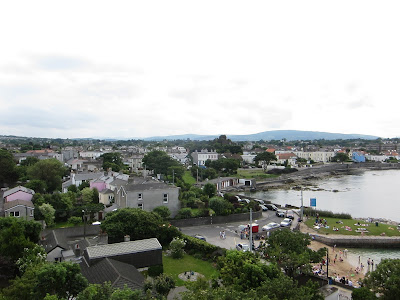I began the day at Kilmainham Gaol, a historic jail a short bus ride away from the centre of Dublin. Kilmainham was known for its Victorian innovations of individualized cells and natural light. The oval, open structure of one of the main sections allowed the guards to view many prison cells at once.

I had some fun being trapped in one of the cells:
Most of the jail, however, was very somber. We walked through narrow corridors that were cold, dark, drafty and grey, opening to a courtyard.
Kilmainhaim is most famous as the site where the Easter Rising leaders were held and executed. At the site of their execution, there stands a plaque with all their names, and an Irish flag. The Rising was a critical turning point in Ireland's struggle for independence. Initially, public opinion was against the Rising, but when the leaders were executed one by one by the British, they became martyrs, and public opinion swayed towards violent opposition. The Rising, in turn, was followed by the Irish War for Independence from 1919-1921.
After Kilmainham, I decided to take a trip to Sandy Cove to visit Martello Tower, the location of "Telemachus," the first chapter of Ulysses. I thought the train station was kind of nice:
Sandy Cove is a beautiful suburban area on the water, just outside of Dublin.
Martello Tower off in the distance:
Martello Tower is now home to the James Joyce Museum. There were a lot of people there, although I don't think they were there to learn about Joyce-- they were more interested in swimming. I sincerely wished I had brought a bathing suit...
Inside the museum, there was a lot of great Joyce paraphernalia, including his death mask, a first edition of Ulysses, posters, paintings, letters written by Joyce, etc.
The tower is special not just because it's the opening of Ulysses, but also because Joyce lived there for several days, until his landlord kicked him out by firing a gun right over his head.
One of the rooms where Joyce lived:
After Sandy Cove, I went back to Dublin and spent several hours in the Yeats Exhibition at the National Library. The exhibition was fantastic. When you walk in, there are a series of screens projecting Yeats's poems, along with images that relate to the imagery in the poems. As the poems are projected, they are recited by a diverse cast, from Yeats reciting "The Lake Isle of Innisfree," to Seamus Heaney and Sinead O'Connor. There are different rooms pertaining to different topics surrounding Yeats and his work. Each room has a video documentary describing the topic, including video interviews of different scholars and poets talking about the relevant topic. I particularly enjoyed the video about Yeats and the Occult, as well as the one about Yeats and the Abbey Theatre.
In the evening, I went to see "Outsiders" by David McWilliams at the Abbey. David McWilliams is a leading economist in Ireland who was commissioned by the Abbey to create a piece on the current economic climate. The show was not really a play- it was more of an economics lecture with a set behind it. I thought the set designer made a brave attempt to make McWilliams's script into a work of theatre by creating a dynamic space with which McWilliams could interact, but ultimately I think the limitations of the script were insurmountable. The show consisted of McWilliams ranting for 2 or so hours about how bleak the current economic situation is in Ireland, how the people who caused the crisis are still in charge, how we need to bridge the gap between the "insiders" who are the bankers and the "outsiders" who are the rest of us, and concluded with the affirmation that what Ireland needs is "Joycean capitalism"-- the kind of creative risk-taking that Joyce was so famous for--in order to revitalize the country. The last part, I thought, was an interesting coda to the day.
After the show, I was talking to a gentleman named John Fairleigh. John is on the board of the Stewart Parker Trust, which awards a cash prize every year to the most promising Irish playwright. I told John about my research, and he was very gracious and kind in offering to help me find people to interview, the first of whom would turn out to be Lynne Parker, artistic director of Rough Magic Theatre Company.









No comments:
Post a Comment